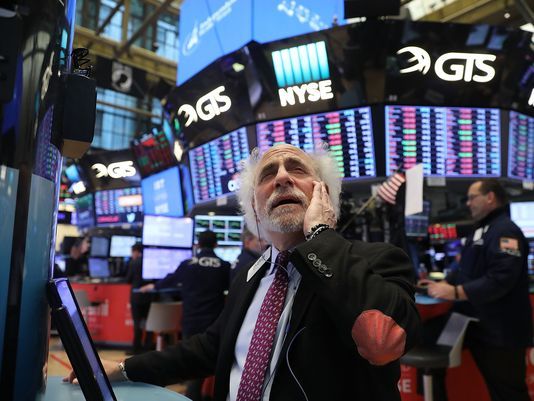
The Dow closed out a turbulent week with a 330-point rebound Friday but still suffered its biggest weekly loss since January 2016, a tumble highlighted by its first official correction in two years.
In a week marked by a pair of 1,000-plus point drops, the two worst days in its 121-year history, the Dow Jones industrial average closed up 330.44 points, or 1.4%, at 24,190.90.
The swings followed a drop of 10%, or a correction, from the latest record highs set by major U.S. indexes two weeks ago. In a sign of how bad things got, by early afternoon Friday, the market was on pace for its worst weekly tumble since October 2008, at the height of the financial crisis.
The Dow ended the week 9.1% off its Jan. 26 high and down 2.1% for the year.
The steep declines spooked stock investors who yanked a record $30 billion out of stock funds in the week ended Feb. 7, according to EPFR Global.
As of Thursday, about $2.49 trillion in value had vanished from the broad Standard & Poor’s 500 stock index since its most recent peak on Jan. 26, according to S&P Dow Jones Indices.
Brian Belski, chief investment strategist at BMO Capital Markets, says finding a market bottom is a process that takes time.
“Investors should avoid the ‘hero complex’ and try to declare a bottom,” he says. “Lows take time to take shape.”
The losses were sparked by fears that interest rates would rise faster than expected because of a growing economy. Higher borrowing costs are viewed as a negative by Wall Street because they slow growth and make stocks less attractive an investment relative to higher-yielding bonds.
Earlier in the week, the 10-year Treasury yield hit 2.88%, its highest level in four years.
The market was able to hold key levels late Friday, which gave investors courage to step in and buy.
Wall Street pros stress that volatility is back and probably will remain for some time.
The weekly losses were broad.
Though the broad market is only halfway to a so-called bear, or drop of 20% or more, 96 stocks in the S&P 500 were down by that amount from their highs, as of Thursday’s close, according to FactSet data.
Financial analysts regard corrections as a normal event but say the latest unusually abrupt plunge might have been triggered by a combination of events that rattled investors. Those include worries about a potential rise in U.S. inflation or interest rates and budget deficits in Washington.
In Washington, President Trump signed a $400 billion budget deal Friday that sharply boosts spending and swells the federal deficit, ending a brief government shutdown.
The market, in its second-longest bull run, had not seen a correction for two years, an unusually long time. Many market watchers had predicted such a fall, saying stock prices had become too expensive relative to company earnings.
“We may have seen the worst, but it’s too early to say for sure. However, our view remains that it’s just another correction,” says Shane Oliver of AMP Capital in a report.
Corrections of up to 15% “are normal,” he says.
“In the absence of a recession, a deep bear market is unlikely,” he says.

